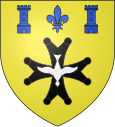Sivergues
| Sivergues | ||
|---|---|---|

|
|
|
| region | Provence-Alpes-Cote d'Azur | |
| Department | Vaucluse | |
| Arrondissement | Apt | |
| Canton | Apt | |
| Community association | Pays d'Apt-Luberon | |
| Coordinates | 43 ° 50 ' N , 5 ° 24' E | |
| height | 430-993 m | |
| surface | 9.39 km 2 | |
| Residents | 43 (January 1, 2017) | |
| Population density | 5 inhabitants / km 2 | |
| Post Code | 84400 | |
| INSEE code | 84128 | |
 Sivergues |
||
Sivergues is a French municipality with 43 inhabitants (at January 1, 2017) in the department of Vaucluse in the region Provence-Alpes-Cote d'Azur . It belongs to the canton of Apt in the Apt arrondissement .
geography
Sivergues is located in the south of the Vaucluse department and is surrounded by the municipalities of Buoux , Vaugines , Cucuron , Auribeau and Saignon . Apt in the north is the closest town at five kilometers away.
To the south of the commune rise the mountains of the Grand Luberon . The municipality is part of the Luberon Regional Nature Park . The north-western boundary of the municipality is formed by the 23-kilometer- long Aigue Brun river , which flows into the Durance west of Cadenet .
traffic
The high-altitude town of Sivergues can only be reached from the northeast via the départementale D114 route.
history
Sivergues was a feudal estate dependent on Saignon and became independent in the 14th century. After several major epidemics , the village was repopulated between 1501 and 1523, particularly by eight Waldensian families who settled here. Since then, the history of the place populated by Protestants and Catholics has been primarily religious.
Place name
The place name probably goes back to a Roman named Sivius , who owned a manor nearby. Legend has it that the name of the place is derived from a monastery called Six-Vierges ("Six Virgins"), which was supposedly founded in the fifth century by the wife of St. Castor and six young girls.
Population development
| year | 1962 | 1968 | 1975 | 1982 | 1990 | 1999 | 2006 | 2008 |
|---|---|---|---|---|---|---|---|---|
| Residents | 29 | 33 | 38 | 41 | 39 | 30th | 44 | 48 |
Attractions
Fort de l'Archidiacre , converted into a hostel , is located at the foot of a rock overlooking the Aiguebrun valley. It was fortified by Bertrand de Bot, an archdeacon of the Cathedral of Apt . A door from the 13th century and the old vault have been preserved .
The small church of St-Pierre-et-St-Marie was built in the 16th century and was intended for a small Catholic community: in 1683, two Catholic families with 21 members are attested.
The construction of the Protestant church probably goes back to the middle of the 19th century. Before that, the community's Huguenots met in the caves of the Luberon, for example in the Bastide Perrons .
Half an hour's walk from the village is a farmhouse run as a hostel called Castellas . Here you can find the remains of the Romanesque church of St. Trophime, including the cemetery, which is called cimetière Vaudois (" Waldensian cemetery ").
Others
The community is best known for the novel L'Habitant de Sivergue by Henri Bosco .
literature
- Michel Albarède et al .: Vaucluse (= Encyclopédies du Voyage ). Gallimard Loisirs, Paris 2007, ISBN 2-7424-1900-4 , p. 272-273 .
- Marie-Christine Mansuy et al .: Parc Naturel Régional du Luberon (= Encyclopédies du Voyage ). Gallimard Loisirs, Paris 2010, ISBN 978-2-7424-2737-6 , pp. 93 .
Web links
- Website of the "Les Amis de Sivergues" (French)
- History of Sivergues ( Memento of December 3, 2006 in the Internet Archive ) (French)

